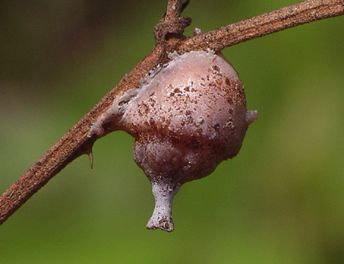 odd thing found in Florida | 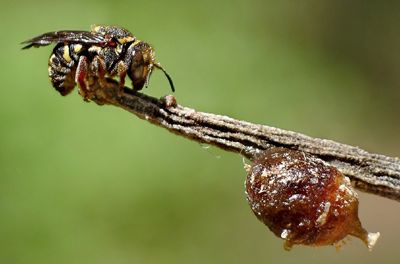 Anthidiellum notatum & brood cell from Texas |
A couple of months ago, during one of our fauna surveys at the Lady Bird Johnson Wildflower Center here in Austin, I found a very similar looking object attached to a plant. While this version was not exactly the same, its overall shape and texture immediately brought to mind the Florida discovery from long ago. This time, I photographed it and, thinking that it might possibly have been made by an insect, such as for eggs or a pupa, sent the image to a friend who happens to be an expert in tracks, signs and other artifacts related to arthropods. He didn't know what it was either, but he suggested that I collect it and see what emerges.
 odd thing found in Florida |  Anthidiellum notatum & brood cell from Texas |
I took his advice and went back a few days later, brought it home, and placed it in a jar where I could check it regularly. Two months later, something DID emerge. A tiny bee, easily recognizable, had chewed its way out. Armed with the knowledge that this was a brood cell of Anthidiellum notatum, I looked for information on the internet and found several images that matched perfectly. It's funny how, with all the knowledge at the tips our fingers on a keyboard, it is still possible to be totally perplexed by something that we cannot put a label on and thus ask Google to help explain. But sometimes the old-fashioned method of wait-and-see works just fine.
So, after this experience, I thought about how little I actually understand about something as common as this tiny native solitary bee. In fact, except for a few experts who study bees, hardly anybody even notices them, let alone has seen how they nest. I've been lucky to be acquainted with an expert who does know all about bees, especially here in Texas. In fact, if I'd known that the little resin capsule was made by a bee, he would have been the first person I would have consulted.
For all the interest in pollination, gardening and native plants that seems to be thriving amongst the nature and ecology oriented crowd, there is still a general lack of awareness when it comes to bees. Many people cannot even recognize a honey bee and even more are surprised to find out that the species is not native to North America. Beyond bumble bees, most of our native bees are a nameless group of unidentified insects flying around flowers.
Here is a quick introduction to the native bees in central Texas:
A fair number of bees are called digger bees, and the females dig holes in the ground where they then lay their eggs. Other bees chew holes in wood or excavate the pith of plant stems for their nests. Still others find cracks in trees or rocks and make just a few improvements to accommodate their eggs and the provisions for the young. Honey bees make the most complex, and downright beautiful, nests, with their evenly spaced six-sided wax cells. The nests of bumble bees, however, are a chaotic cluster of dirty looking oval-shaped cells, usually in the ground under piles of grass or hay. Although I have occasionally found feral honey bee nests in trees, I never saw a nest of bumble bees until an employee at the Wildflower Center discovered one while trimming grass. He marked it with little flags, both to alert other workers to keep clear and to let me know where it was located. During one of our surveys, we gathered around and watched as the busy workers entered and exited the nest through several openings that were barely visible under a large clump of grass.
 honey bee in hive |  old bumble bee nest |
While many kinds of bee nests are simple burrows or chambers, the nests of some species in the family Megachilidae are more complex (and therefore more interesting to us humans). The Anthidiellum nest mentioned at the beginning of this essay is one example. Another genus, Megachile, is the source of the family name and includes the leaf-cutter bees. Most gardeners at one time or another have noticed the cookie-cutter round holes in leaves and even flower petals that are the hallmark of these bees. A female leaf-cutter bee uses her jaws to quickly clip a round or oval piece of some appropriately textured plant. The cutting takes about 5 seconds, which makes it really hard to snap a photo before the bee is finished. After the piece is cut loose, the bee curls it up with her legs and flies off with it. The plant pieces are used to line the nest, creating a waterproof barrier to keep out fungus and other pathogens that might spoil the nectar/pollen provisions or harm the bee larva. I've seen the nests under rocks or between pieces of stacked lumber. They look sort of like very strange rolled cigarettes.
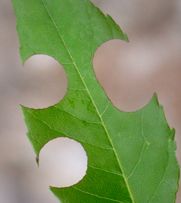 leaf-cutter damage |  leaf-cutter bee with leaf piece | 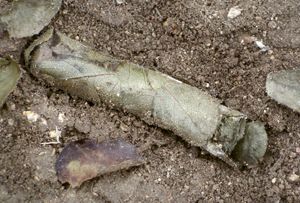 leaf-cutter bee nest |
Yet another megachilid bee that goes through a lot of trouble to protect its offspring is the mason bee, Osmia ribifloris. These lovely metallic blue bees are common in the early spring. When I first saw one chewing on the edges of sumac leaves, I couldn't figure out just why it was doing that. Once again, having access to a knowledgeable person is a real boon. I asked my friend what the heck the bee was doing, and he had the answer. These bees use old mud dauber nests for their own eggs. They renovate the wasp's nest, using leaf masticate, a mix of saliva and chewed up plant material. And so yet another mystery was solved with this bit of information, as I had previously found a mud dauber cell that had bright green "plaster" sealing up the openings. It's so nice when things just fall into place and another tiny bit of our world is revealed for the intricate and finely-tuned ecosystem that it is.
 mason bee chewing on leaves | 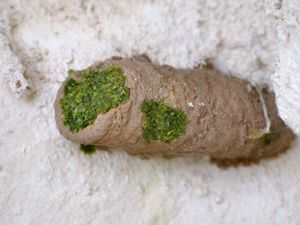 mud dauber nest renovated by mason bee |
Learning about how bees provide for the next generation, and manage to do so in spite of the incredible amount of work and time involved, is just one of the rewarding results that occurs when I poke around outside, watch the tiny animals, and pursue the myriad questions that inevitably arise whenever I see something happen that I never before noticed. Unraveling mysteries is simply a lot of fun.